Publication
auri Research Brief
Architecture and Urban Space in the Urban Air Mobility (UAM) Era
- No.81
- 2022.08.22
- Hit 9604
- Nam, Seongwoo Associate Research Fellow
In the era of UAM, the functions of roads and parking lots used for automobiles need to be prepared for a transition. In terms of buildings and structures, definitions of new concepts that merge UAM infrastructure and related standards are necessary. Also, locations for vertiport sites must be determined in the urban planning stage and regulatory measures must be established with regard to the height and locations of buildings considering flight paths in order to resolve potential noise, privacy, and safety issues stemming from UAM flights.
The UAM Era is Coming
The era of urban air mobility (UAM) is approaching. UAM has recently emerged as a replacement for automobiles, the most significant and dominant mode of transportation since its first development by Benz in 1886. The international community, nations, and corporations are increasingly engaging themselves in competition to lead the relevant markets.
UAM refers to a safe and efficient air transport system that transports passengers or cargo at low altitudes in urban and suburban areas utilizing highly automated aircraft (US Federal Aviation Administration). UAM does not use fossil fuels but instead uses batteries as the power source and is thus considered an environmentally friendly transportation mode that can contribute to carbon neutrality.
The UAM market is predicted to expand drastically from 7 billion US dollars in 2020 to 156 billion dollars in 2026 and then to 322 billion in 2030 and 1,474 billion in 2040 (Han, 2022). Aircraft development companies such as airlines, platform companies such as Uber, and mobility companies such as Hyundai have quickly begun research and development and have announced products in order to dominate the UAM market. Specifically, Uber founded its subsidiary UAM company Elevate in 2016 and plans for commercialization by 2023 (Ministry of Land, Infrastructure, and Transport, 2020).
Concerning the international community and nations, the US and Europe are in the process of establishing standards concerning aircraft technologies, and a number of aircraft are undergoing the certification process (Ministry of Land, Infrastructure, and Transport, 2020). In 2022, the World Economic Forum launched a coalition of cities and regions for cooperation to make UAM services a reality. Founding cities and regions included Amsterdam, the state of Massachusetts, Orlando, Los Angeles, Île-de-France, and Sao Paulo (World Economic Forum, 2022).
In May of 2020, Korea announced strategies to realize and develop UAM into a key industry in the future and to establish the infrastructure and systems for commercialization by 2025 through the “K-UAM Technology Roadmap.” Among the 110 national tasks announced by the Yoon Suk-Yeol administration, UAM is included as a core future industry in the land and transportation sector.
At this point in time when UAM is highlighted as the next-generation mode of transportation, what are aspects that must be prepared in terms of architecture and urban planning?
Changes in the Urban Space by a New Mode of Transportation
The popularization of automobiles in the early 20th century significantly changed the urban space structure. Prior to this, long-distance transportation relied on railroads, but as automobiles for the masses were produced, such as the Ford Model T, and roads were constructed, there was a boom in residential construction in more remote areas and ultra-suburbanization proceeded.
Since the 1950s, suburbanization in the US has been centered on the automobile-owning middle class and the white working class. During this period, the production of multi-purpose cars for commuting, shopping, and travel increased, and traffic congestion due to the increased numbers of automobiles emerged as an urban problem, which led to the construction of new roads (American on the Move).
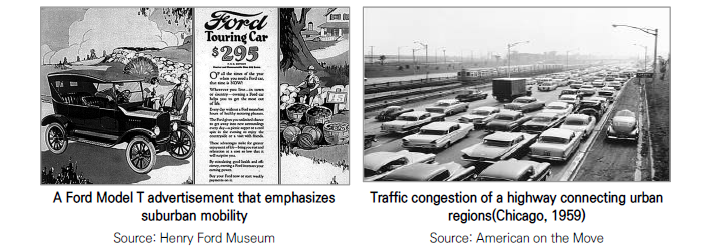
The introduction of the new mode of transportation of automobiles has had a significant impact on the development of modern urban spaces. Thus, it cannot be doubted that the development and distribution of UAM will bring about changes to the current urban space, and we must pay attention to those changes.
UAM, Flying Cars, and Vertiports
Various science fiction movies have depicted “flying cars.” Flying cars called Spinners are featured in the movie Blade Runner, released in 1982. In the movie “The Fifth Element” set in the year 2259, “flying cars” pass through between buildings and park perpendicularly on the sides of buildings.

UAM is the realization of the flying cars that were portrayed in science fiction movies set in the near future. Of course, they take on different forms from those shown in movies. Currently, the most representative form of UAM aircraft is the electric Vertical Take-Off and Landing Aircraft (eVTOL). The eVTOL can travels 30~50km in urban areas at altitudes of 150~3,500m, which is higher than that of conventional helicopters. There are various eVTOL types, including the “multicopter,” “vectored thrust,” and “lift+cruise” types. Currently there are approximately 400 UAM aircraft under development in 45 countries worldwide (Han, 2022).
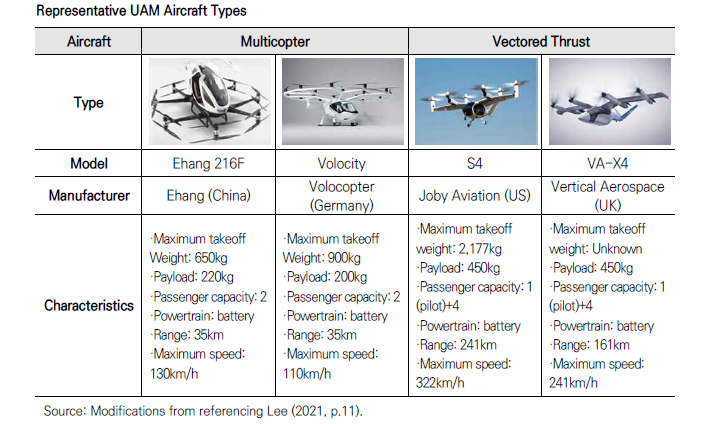
The key infrastructure of UAM is the “vertiport,” or a facility for vertical takeoff and landing operations. A runway is not necessary given that UAM allows for vertical takeoff and landing, like helicopters. While heliports or takeoff and landing facilities for helicopters are used for emergencies and are typically used occasionally, the vertiports for UAM used as public transportation are predicted to be used much more frequently.
Such vertiports must be located in open areas in cities or on the rooftops of buildings, where takeoffs and landings can be performed with greater convenience in order to minimize surrounding obstacles for safety purposes. In addition, takeoff and landing facilities and those for charging, maintenance, boarding, and transfers are expected to be integrated into various commercial, sales, culture, and assembly facilities (Son et al., 2021). The US Federal Aviation Administration (FAA) has distributed Engineering Brief No. 105, a draft of interim guidance for designing vertiports. The brief includes details on TLOF (touchdown and lift off areas), FATO (final approach and take-off areas), safety areas, and flight rules to ensure visibility during takeoff and landing. Looking at the composition of vertiports on the rooftops of buildings, an example arrangement of an access ramp and TLOF, FATO and safety areas can be found. It can also be observed that there are additional devices that must be installed, such as beacons for location identification and devices that determine wind speeds and wind directions. Also, the guidelines include the range of space required to secure flight visibility for takeoff and landing.
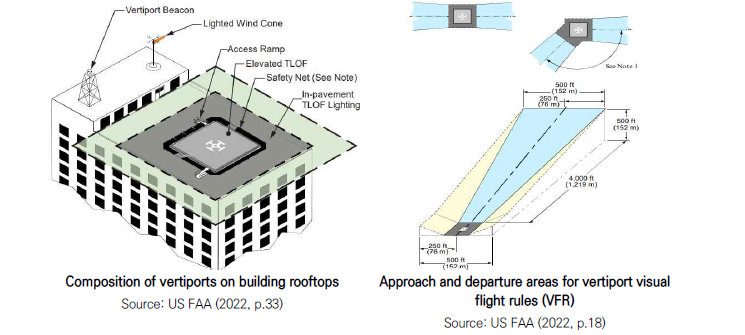
Architecture and Urban Space for the Coming UAM Era
For the coming UAM era, there are a number of preparations necessary to improve flight safety and accommodate changes in the urban spatial structure and related infrastructure.
First, there will be a transition of the urban space previously used for automobiles. The possibility of the repurposing of urban space used for facilities and structures, such as roads and parking lots that facilitated ground transportation, is feasible, and a substantial portion of these spaces could be used as spaces for people, such as parks, museums, and performance centers (Technology & Innovation, 2021). Similar to the major transition of urban spatial structure that took place due to the distribution of automobiles in the early 20th century, the changes in urban spaces that will occur from the introduction of UAM need to be predicted and prepared for.
Second, the concept of structures that accommodate UAM must be defined and their construction standards established. Looking at the architectural design cases with “Uber Air Skyport” or the vertiport of Uber applied, various facilities are integrated, including detached/apartment houses, neighborhood facilities, culture and assembly facilities, sales facilities, transportation facilities, lodging facilities, warehouse facilities, and automobile-related facilities. Thus, the definition of a new concept that is differentiated from the concept of conventional buildings and structures is necessary. Moreover, UAM takeoffs and landings require a minimum facility area. For example, when a space of around 15×15m is allocated for UAM takeoffs and landings based on the “Conceptual eVTOL” model of Uber, a larger area is required when including the safety area. Article 13 of the “Rules on the Standard of Building Evacuation Structure” states that the length and width of heliports be at least 15m each, with structures, landscaping facilities, and railings that may obstruct takeoffs and landings prohibited.
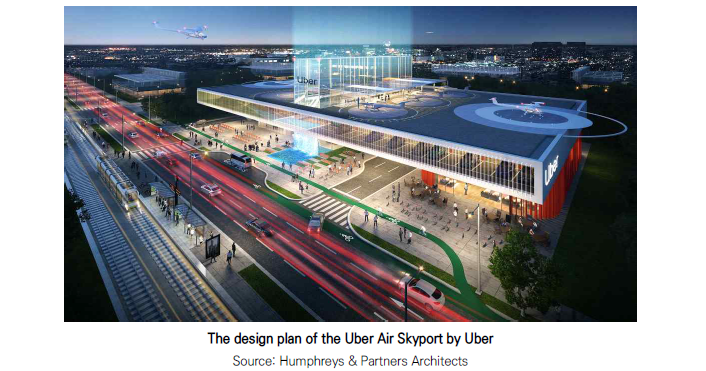
Finally, urban designs that consider noise, invasion of privacy, and safety issues that may occur from UAM flights in a city may be required. UAM utilizes propellers that are smaller than those of helicopters such that there will be somewhat less noise, but it will be difficult completely to block noise inside buildings and in outside spaces when UAM vehicles are traveling within urban spaces. Plus, personal spaces may become visible when flying in close proximity to buildings, and there is the possibility of collisions. Taking into consideration such potential issues, guidelines appear necessary for the determination of vertiport locations in the urban design phase and regulations pertaining to the heights and locations of buildings in relation to flight paths.
The “K-UAM Concept of Operations 1.0” published in September of 2021 mentions the height of buildings as a risk factor for the safe operation of UAM and emphasizes the need for the strict management of flight paths rather than allowing free flights, as regional noise standards may vary according to the flight path (UAM Team Korea, 2021).
UAM will one way or another impact and change architecture and urban spaces, akin to how automobiles did so 100 years ago. At this point in time, it is difficult to say what those changes and effects will be; however, this is a time that requires wise decision-making and efforts to predict and prepare to absorb changes in architecture and urban spaces while continuously monitoring the advancements of industries related to UAM.
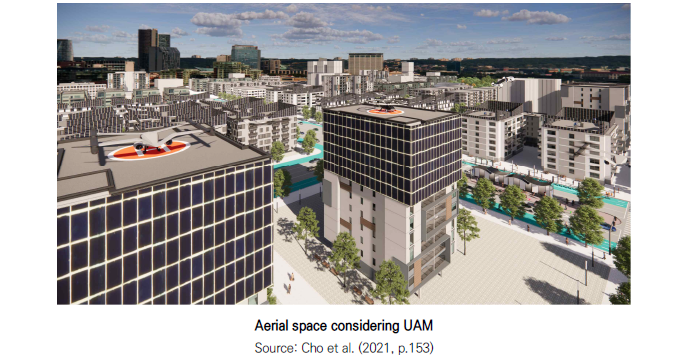
- Ministry of Land, Infrastructure and Transport. (2020). K-UAM Technology Roadmap.
- US FAA. Urban Air Mobility and Advanced Air Mobility. https://www.faa.gov/uas/advanced_operations/urban_air_ mobility (Access date: 7 Jun 2022)
- US FAA. (2022.6.) Engineering Brief No. 105, Vertiport Design. Draft.
- World Economic Forum. (29 Mar 2022) Local Leaders Join New Coalition to Advance Urban Air Mobility Around the World.
- Son, Joo Chan, Yoon, Dong-Sik. (2021). A Study of the architectural planning and design for UAM (Urban Air Mobility) Vertiport. Architectural Institute of Korea 2021 Spring Conference Proceeding, 41(1), 94-97.
- Joong-Hyun Lee. (2021). The Future of Urban Air Mobility (UAM). Technology & Innovation, 499, 10-12.
- Cho, Sangkyu, Kim, Younghyun, Park, Sungnam, Nam, Seongwoo, Yoon, Hosun, Moon, Boram & Lee, Jaeseung. (2021). A Research of Planning & Design Methods for Smart City Services and Technologies. Architecture & Urban Research Institute.
- Han, Sang-Heon. (2022). Global UAM Market Report. Korea Aerospace Industries (KAI) webzine. March 4 article.
- American on the Move. National Museum of American History. https://americanhistory.si.edu/america-on-the-move (Access date: 3 May 2022)
- Baxter, S. (2017.2.11.) Dude, where's my flying car? Financial Times. https://www.ft.com/content/242bcf42-eee5-11e6- ba01-119a44939bb6 (Access date: 7 Jun 2022)
- Henry Ford Museum. "Every day without a Ford means lost hours of healthy motoring pleasure." Ford Touring Car.
- Humphreys & Partners Architects. UBER Unveils New Skyport Designs For Uber Air.
- Suderman, P. (2 Oct 2017) Blade Runner's 2019 Los Angeles helped define the American city of the future. Voxmedia. https://www.vox.com/culture/2017/10/2/16375126/blade-runner-future-city-ridley-scott (Access date: 2022.6.7.)
- UAM Team Korea. (Sept 2021) K-UAM Concept of Operations 1.0.
